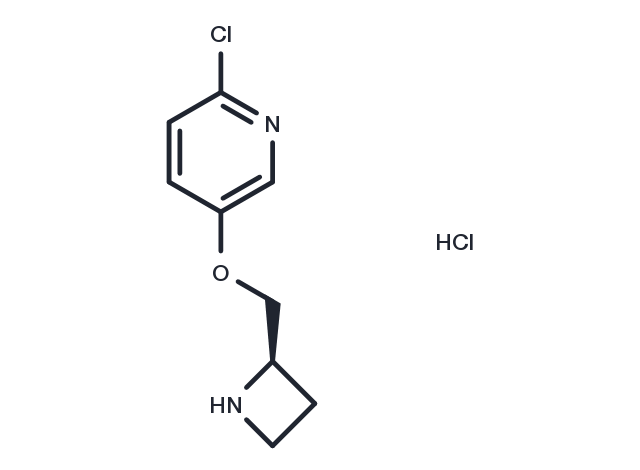Powder: -20°C for 3 years | In solvent: -80°C for 1 year


Tebanicline hydrochloride (Ebanicline hydrochloride) , is an effective synthetic nicotinic (non-opioid) analgesic drug.

| Pack Size | Availability | Price/USD | Quantity |
|---|---|---|---|
| 1 mg | In stock | $ 37.00 | |
| 2 mg | In stock | $ 51.00 | |
| 5 mg | In stock | $ 91.00 | |
| 10 mg | In stock | $ 141.00 | |
| 25 mg | In stock | $ 277.00 | |
| 50 mg | In stock | $ 498.00 | |
| 100 mg | In stock | $ 725.00 | |
| 500 mg | In stock | $ 1,520.00 |



| Description | Tebanicline hydrochloride (Ebanicline hydrochloride) , is an effective synthetic nicotinic (non-opioid) analgesic drug. |
| Targets&IC50 | nAChR:37 pM(ki) |
| In vitro | Tebanicline is a novel, potent cholinergic nAChR ligand with analgesic properties that shows preferential selectivity for neuronal nAChRs. It inhibits the binding of cytisine to α4β2 neuronal nAChRs with a Ki of 37 pM. Functionally, tebanicline is an agonist. At the transfected human α4β2 neuronal nAChR in K177 cells, with increased 86Rb+ efflux as a measure of cation efflux, ABT-594 has an EC50 value of 140 nM with an intrinsic activitycompared with (?)-nicotine of 130%; at the nAChR subtype expressed in IMR-32 cells, an EC50 of 340 nM; at the F11 dorsal root ganglion cell line, an EC50 of 1220 nM; and via direct measurement of ion currents, an EC50 value of 56,000 nM at the human α7 homo-oligimeric nAChR produced in oocytes[1] |
| In vivo | Tebanicline is a potent antinociceptive agent with full efficacy in models of acute and persistent pain and that these effects are mediated predominately by an action at central neuronal nAChRs[2]. Tebanicline produces significant antinociceptive effects in mice against both acute noxious thermal stimulation. ABT-594 is orally active, but 10-fold less potent by this route than after i.p. administration. The antinociceptive effect of ABT-594 is prevented, but not reversed, by the noncompetitive neuronal nicotinic acetylcholine receptor antagonist[3]. Tebanicline has antinociceptive effects in rat models of acute thermal, persistent chemical, and neuropathic pain. Direct injection of tebanicline into the nucleus raphe magnus (NRM) is antinociceptive in a thermal threshold test and destruction of serotonergic neurons in the NRM attenuates the effect of systemic tebanicline[4]. |
| Synonyms | ABT-594 hydrochloride, Ebanicline hydrochloride |
| Molecular Weight | 235.11 |
| Formula | C9H12Cl2N2O |
| CAS No. | 203564-54-9 |
Powder: -20°C for 3 years | In solvent: -80°C for 1 year
DMSO: 34 mg/mL (144.61 mM)
You can also refer to dose conversion for different animals. More
bottom
Please see Inhibitor Handling Instructions for more frequently ask questions. Topics include: how to prepare stock solutions, how to store products, and cautions on cell-based assays & animal experiments, etc.
Tebanicline hydrochloride 203564-54-9 Neuroscience AChR ABT 594 Hydrochloride ABT594 Hydrochloride ABT-594 hydrochloride Ebanicline hydrochloride ABT-594 Hydrochloride Tebanicline Hydrochloride Ebanicline Hydrochloride inhibitor inhibit
